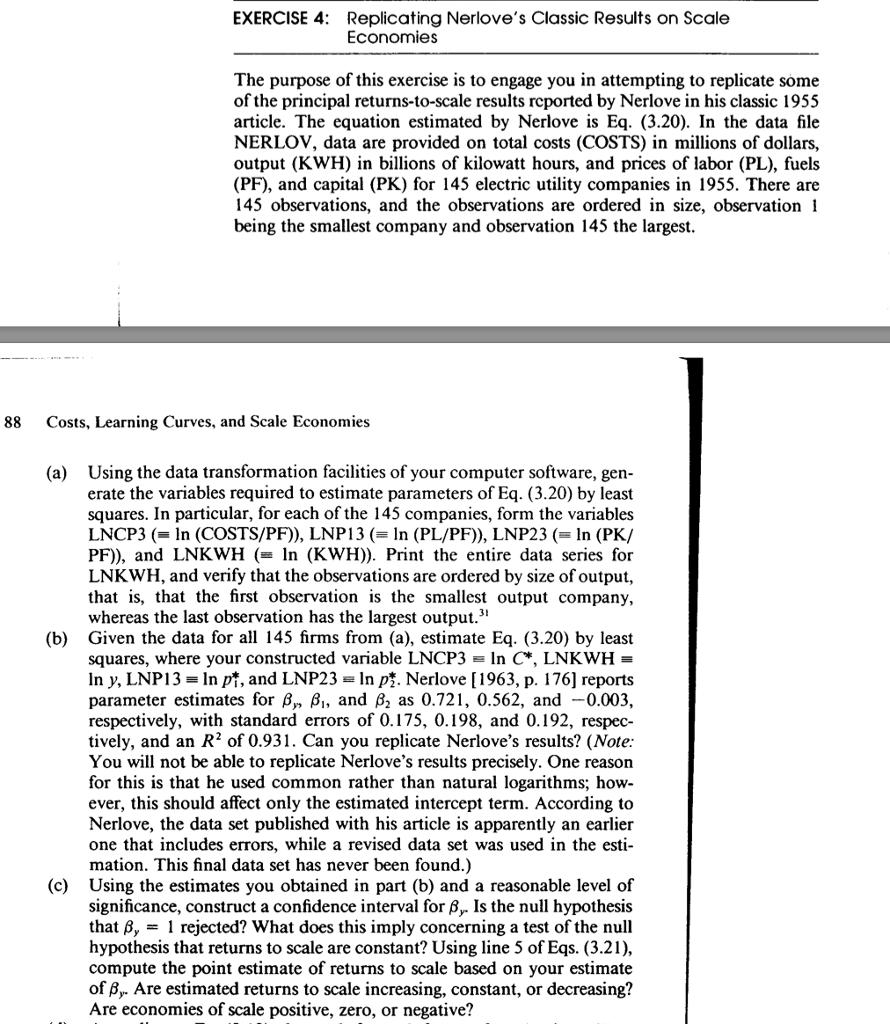Answered step by step
Verified Expert Solution
Question
1 Approved Answer
88 EXERCISE 4: Replicating Nerlove's Classic Results on Scale Economies The purpose of this exercise is to engage you in attempting to replicate some

88 EXERCISE 4: Replicating Nerlove's Classic Results on Scale Economies The purpose of this exercise is to engage you in attempting to replicate some of the principal returns-to-scale results reported by Nerlove in his classic 1955 article. The equation estimated by Nerlove is Eq. (3.20). In the data file NERLOV, data are provided on total costs (COSTS) in millions of dollars, output (KWH) in billions of kilowatt hours, and prices of labor (PL), fuels (PF), and capital (PK) for 145 electric utility companies in 1955. There are 145 observations, and the observations are ordered in size, observation 1 being the smallest company and observation 145 the largest. Costs, Learning Curves, and Scale Economies (a) Using the data transformation facilities of your computer software, gen- erate the variables required to estimate parameters of Eq. (3.20) by least squares. In particular, for each of the 145 companies, form the variables LNCP3 (= ln (COSTS/PF)), LNP13 (= In (PL/PF)), LNP23 (= ln (PK/ PF)), and LNKWH (= ln (KWH)). Print the entire data series for LNKWH, and verify that the observations are ordered by size of output, that is, that the first observation is the smallest output company, whereas the last observation has the largest output.1 (b) Given the data for all 145 firms from (a), estimate Eq. (3.20) by least squares, where your constructed variable LNCP3 In C*, LNKWH = In y, LNP13 = In pt, and LNP23 = In pz. Nerlove [1963, p. 176] reports parameter estimates for B, B, and 6 as 0.721, 0.562, and -0.003, respectively, with standard errors of 0.175, 0.198, and 0.192, respec- tively, and an R2 of 0.931. Can you replicate Nerlove's results? (Note: You will not be able to replicate Nerlove's results precisely. One reason for this is that he used common rather than natural logarithms; how- ever, this should affect only the estimated intercept term. According to Nerlove, the data set published with his article apparently an earlier one that includes errors, while a revised data set was used in the esti- mation. This final data set has never been found.) (c) Using the estimates you obtained in part (b) and a reasonable level of significance, construct a confidence interval for 8,. Is the null hypothesis that B, 1 rejected? What does this imply concerning a test of the null hypothesis that returns to scale are constant? Using line 5 of Eqs. (3.21), compute the point estimate of returns to scale based on your estimate of 6. Are estimated returns to scale increasing, constant, or decreasing? Are economies of scale positive, zero, or negative?
Step by Step Solution
★★★★★
3.42 Rating (152 Votes )
There are 3 Steps involved in it
Step: 1

Get Instant Access to Expert-Tailored Solutions
See step-by-step solutions with expert insights and AI powered tools for academic success
Step: 2

Step: 3

Ace Your Homework with AI
Get the answers you need in no time with our AI-driven, step-by-step assistance
Get Started


